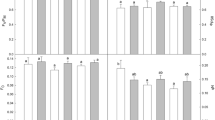Abstract
Temperature dependent chlorophyll a fluorescence induction transients in leaf discs of two cucumber lines were measured between 27°C and 0°C. Cucumber cv Farbio was compared with line 45 with a better growth capacity at suboptimal temperature (20°C D/12°C N). With decreasing temperature breaks were evident in the rate of change of the fast fluorescence maximum P. After growth at normal temperature (25°C D/20°C N) the temperature dependent yield of P of Farbio showed one break at 13°C. The curve of Farbio grown at suboptimal temperature (20°C D/12°C N) showed two breaks at 19°C and 4°C. A similar curve with breaks at 21°C and 7°C was observed in line 45 grown at normal conditions. After growth at suboptimal conditions line 45 showed breaks at 16°C and 8°C. Temperature dependent changes of the fluorescence yield of the slow maximum M minus the yield of the minimum S showed optimum curves. Young leaves (10 day-old) of both lines showed an optimal value of M-S at 3°C. In older leaves (35 day-old) the optimum shifted to 12°C with Farbio and 18°C with line 45 suggesting an influence of plant age on fluorescence properties. Plants grown at suboptimal conditions retained their optimum at 6°C (Farbio) or 3°C (line 45).
Access this chapter
Tax calculation will be finalised at checkout
Purchases are for personal use only
Preview
Unable to display preview. Download preview PDF.
Similar content being viewed by others
References
Den Nijs, A.P.M.(1980) Adaptation of the glasshouse cucumber to lower temperatures in winter by breeding. Acta Hortic. 118:65–72.
Fork, D.C. and Murata, N. (1979) Effect of growth temperature on the lipid and fatty acid composition, and the dependence on temperature of light induced redox reactions of cytochrome f and light energy redistribution in the thermophilic blue-green alga Syncchococcus lividus. Plant Physiol. 63:524–530.
Murata, N. and Fork, D.C. (1975) Temperature depedence of chlorphyll a fluorescence in relation to the physical phase of membrane lipids in Algae and higher plants. Plant Physiol. 56:791–796.
Murata, N., Throughton, J.H. and Fork, D.C. (1975) Relationships between the transition of the physical phase of membrane lipids and photosynthetic parameters in Anacystis nidulans and lettuce and spinach chloroplasts. Plant Physiol. 56:508–517.
Schreiber, U. and Berry, J.A. (1977) Heat induced changes of chlorophyll fluorescence in intact leaves correlated with damage of the photosynthetic apparatus. Planta 136:233–238.
Smillie, R.M. (1979) In Lyons, J.M., Graham, D. and Raison, J.K., eds. Low temperature stress in crop plants, pp. 187–202. New York: Academic Press.
Melcarec, P.K. and Brown, G.N. (1977) The effect of chilling stress on the chlorophyll fluorescence of leaves. Plant and Cell Physiol. 18:1099–1107.
Govindjee and Papageorgiou, G. (1971) In Giese, ed. Photophysiology Vol. VI, pp. 1–46. New York: Academic Press.
Duysens, L.N.M. and Sweers, H.E. (1963) Mechanism of two photochemical reactions in algae as studied by means of fluorescence. In Ashida, J., ed. Studies on micro algae and photosynthetic bacteria, pp. 353–372. Tokyo: Univ. of Tokyo Press.
Yamagishi, A., Satoh, K. and Katoh, S. (1978) Fluorescence induction in chloroplasts isolated from the green alga Byopsis maxima. Plant and Cell Physiol. 19:17–25.
Yamamoto, Y. and Nishimura, M. (1976) Characteristics of light induced H+ transport in spinach chloroplasts at lower temperatures. Plant and Cell Physiol. 17:17–21.
Horvath, I., Vigh, L., Woltjes, J., Van Hasselt, Ph.R. and Kuiper, P.J.C. (1982) In Wintermans, J.F.G.M. and Kuiper, P.J.C., eds. Proceedings of the 5th International Symposium on the Biochemistry and Metabolism of Plant Lipids (in press). Amsterdam: Elsevier.
Author information
Authors and Affiliations
Editor information
Editors and Affiliations
Rights and permissions
Copyright information
© 1983 Martinus Nijhoff/Dr W. Junk Publishers, The Hague
About this chapter
Cite this chapter
van Hasselt, P.R., Woltjes, J., de Jong, F. (1983). The Effect of Temperature on Chlorophyll Fluorescence Induction of Cucumber Lines Differing in Growth Capacity at Suboptimal Conditions. In: Marcelle, R., Clijsters, H., van Poucke, M. (eds) Effects of Stress on Photosynthesis. Advances in Agricultural Biotechnology, vol 3. Springer, Dordrecht. https://doi.org/10.1007/978-94-009-6813-4_28
Download citation
DOI: https://doi.org/10.1007/978-94-009-6813-4_28
Publisher Name: Springer, Dordrecht
Print ISBN: 978-94-009-6815-8
Online ISBN: 978-94-009-6813-4
eBook Packages: Springer Book Archive




